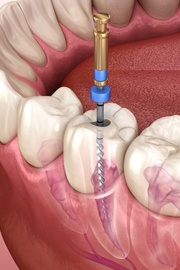Endodontics – Asheville, NC
Saving Badly Damaged or Decayed Teeth

Dental care isn’t just about looking for cavities and removing plaque from the teeth and gums. There are numerous dental specialties that focus on a variety of dental needs. Endodontics is the area of dentistry concerned with the soft tissues inside the tooth. Thanks to Dr. White’s extensive training, he is able to perform a variety of endodontic treatments in order to save decayed and infected teeth from extraction. Call our office if you have a persistent toothache or another warning sign of a tooth infection.
When Do You Need Endodontic Care?

Your tooth contains a collection of soft tissue called the pulp, which contains the tooth’s nerves as well as various arteries, veins, and blood tissues. The pulp can become infected due to a deep cavity or fracture. Said infections are normally very painful, and if they go untreated for too long, the pulp could die. Eventually, the infection could spread beyond the roots of the tooth, causing the nearby bone tissue to degenerate. As a direct result, the tooth would eventually become lost. The endodontic care that Dr. White offers is meant to stop these infections before the tooth is beyond saving.
Root Canal Treatments

Root canal therapy is perhaps the most well-known form of endodontic care. It simply involves removing the damaged or dead pulp along with any other infected material. The treatment normally takes around one to three appointments. A small access hole is made in the tooth so that he pulp can be taken out. Medication might be placed in the tooth to fight remaining bacteria. By the end of the procedure, the root canal is reshaped, refilled, and resealed.
Root canal therapy has a reputation for being especially painful, but this isn’t really true. One of the goals is to stop the pain linked to the pulp infection. The tooth will start feeling better right away after the treatment; you may still experience some level of discomfort or swelling for a couple of days, but it should normally fade in a relatively short amount of time.
Pulpotomy

The baby teeth are just as vulnerable to infection as permanent teeth. It’s important that these temporary teeth are protected so that they don’t fall out before they’re supposed to. A pulpotomy is similar to a root canal in that it’s meant to save a tooth from being extracted. The major difference is that only the pulp in the crown of the tooth is removed; the pulp in the root canal is left alone. Full pulpectomies (where all of the pulp is removed) may need to be performed depending on how severe the infection is.
Endodontic Retreatment
On occasion, root canal therapy might fail to completely remove the infection, or a new infection might occur due to the inner portions of the tooth becoming exposed again for one reason or another. It’s still often possible to save the tooth if this happens. It often involves making a small incision in the gum tissue so that Dr. White can remove a small portion from the tip of the tooth root. This gives us a chance to extract any part of the pulp and nerve system that remains.

